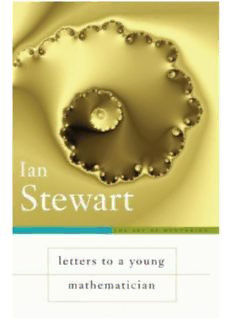
Letters to a Young Mathematician (Art of Mentoring) PDF
Preview Letters to a Young Mathematician (Art of Mentoring)
I Ian Stewart letters to a young mathematician A Member of the Perseus Books Group New York O Joat Enterprises 2006 Published by Basic Books, A Member of the Perseus Books Group All rights reserved. Printed in the United States of America. No part of this book may be reproduced in any manner whatsoever without written per- mission except in the case of brief quotations embodied in critical articles and reviews. For information, address Basic Books, 387 Park Avenue South, New York, NY 100168810. Books published by Basic Books are available at special discounts for bulk purchases in the United States by corporations, institutions, and other or- ganizations. For more information, please contact the Special Markets Department at the Perseus Books Group, 11 Cambridge Center, Cam- bridge MA 02 142, or call (617) 252-5298 or (800) 255-15 14, or e-mail [email protected]. Library of Congress Cataloging-in-Publication Data Stewart, Ian. Letters to a young mathematician / Ian Stewart. p. cm. Includes bibliographical references. ISBN-1 3 : 978-0-465-082 3 1-5 (alk. paper) ISBN-10: 0-465-082 3 1-9 (alk. paper) 1. Mathematics-Miscellanea. I. Title. QA99.S84 2006 5 10dc22 In memory of Marjorie Kathleen ("Madge")S tewart 4.2.191 4-1 7.12.2001 and Arthur Reginald ("Nick") Stewart 2.3.191 4-23.8.2004 without whom I would not have been anything, let alone a mathematician. . Contents 1 Why Do Math? 2 How I Almost Became a Lawyer 3 The Breadth of Mathematics 4 Hasn't It All Been Done? 5 Surrounded by Math 6 How Mathematicians Think 7 How to Learn Math 8 Fear of Proofs 9 Can't Computers Solve Everything? 10 Mathematical Storytelling 11 Going for the Jugular 12 Blockbusters 13 Impossible Problems Contents 14 The Career Ladder IS Pure or Applied? 16 Where Do You Get Those Crazy Ideas? 17 How to Teach Math 18 The Mathematical Community 19 Pigs and Pickup Trucks 20 Pleasures and Perils of Collaboration 2 1 Is God a Mathematician? Notes and References Preface "It is a melancholy experience for a professional mathe- matician to find himself writing about mathematics." So the great English mathematician Godfrey Harold Hardy, of the University of Cambridge, opened his 1940 classic A Mathematician 's Apology. Attitudes change. No longer do mathematicians be- lieve that they owe the world an apology. And many are now convinced that writing about mathematics is at least as valuable as writing mathematics, by which Hardy meant new mathematics, new research, new theorems. In fact, many of us feel that it is pointless for mathe- maticians to invent new theorems unless the public gets to hear of them. Not the details, of course, but the gen- eral nature of the enterprise. In particular, that new mathematics is constantly being created, and what it is used for. The world has changed, too, since Hardy's time. A typical day for Hardy consisted in a maximum of four Preface hours of intensive thought about research problems; the rest of the day was then occupied watching the game of cricket, his great nonmathematical passion, and reading the newspapers. He must have fitted in some time for the occasional research student as well, but he was reti- cent about personal matters. A typical day for the mod- ern academic is ten or twelve hours long, with teaching commitments, research grants to pursue, research to be carried out, and liberal doses of pointless bureaucracy to get in the way of anything creative. Hardy was typical of a certain kind of English aca- demic. He set himself high but narrow standards. He valued his chosen field for its own internal elegance and logic, not for its external uses. He was proud that none of his work could have any possible use in warfare, a po- sition with which most of us can sympathize, especially bearing in mind that his book was published in the open- ing years of World War 11. He would be disappointed in the extreme to be resur- rected today and to learn that on the contrary, his beloved theory of numbers plays an essential role in the mathematical theory of cryptography, with evident mili- tary uses. The movie Enigma paints a romanticized view of the period when this connection first began to emerge, in the vital wartime work of the code breakers at Bletch- ley Park. Prominent among them was the tragic figure of Alan Turing-pure mathematician, applied mathemati- cian, and pioneering computer scientist-who commit- Preface ted suicide because he was persecuted for being a homo- sexual, a sexual orientation that was then illegal and con- sidered shameful. Social mores change, too. Hardy's classic little gem sheds a great deal of light on how academic mathematicians viewed themselves and their subject in 1940. It contains important lessons for any would-be young mathematician, but some of these are obscured by the book's outdated attitudes, such as its default assumption that mathematics is strictly a male preserve. It is still worth reading, but only if its opinions are seen in their historical context, and it is not assumed that they all remain valid today. Letters to a Yozlng Mathematician is my attempt to bring some parts of A Mathematician's Apology up to date, namely, those parts that might influence the decisions of a young person contemplating a degree in mathematics and a possible career in the subject. The letters, ad- dressed to "Meg," follow her career in roughly chrono- logical order, from high school through to a tenured position in a university. They discuss a variety of topics, ranging from basic career decisions to the working phi- losophy of professional mathematicians and the nature of their subject. The intention is not merely to offer practical advice, but to give an inside view of the mathe- matical enterprise, and to explain what it is really like to be a mathematician. As a result, many of the issues discussed will also ap- peal to a more general audience, the one for which
Description: